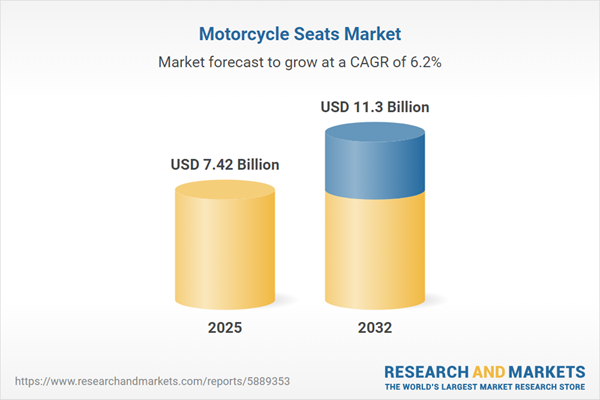Speak directly to the analyst to clarify any post sales queries you may have.
The motorcycle seating market is evolving rapidly as manufacturers and suppliers respond to shifting rider expectations, changing regulatory demands, and the rise of new materials and digital technologies. This transformation is encouraging strategic investment and innovation throughout the value chain, with both established OEMs and emerging brands leveraging advancements to improve rider comfort, safety, and differentiation.
Market Snapshot: Motorcycle Seats Market Size and Growth
The Motorcycle Seats Market grew from USD 6.97 billion in 2024 to USD 7.42 billion in 2025, and is projected to continue expanding at a CAGR of 6.21%, reaching USD 11.30 billion by 2032. Persistent innovation and changing consumer behaviors are fueling this growth trajectory, signifying ongoing investment opportunities for industry leaders.
Scope & Segmentation
This comprehensive study examines global trends, segment performance, and key drivers affecting the motorcycle seating sector. The report provides a deep dive across the following segments and regions, offering granular insights into technologies, materials, and distribution strategies.
- Product Types: Dual (Foam, Leather, Vinyl); OffRoad (Non Padded, Padded); Solo (Foam, Leather, Vinyl); Touring (With Backrest, Without Backrest).
- Distribution Channels: Offline (Dealerships, Independent Retailers, Specialty Stores); Online (Ecommerce Platforms, Manufacturer Websites, Third Party Marketplaces).
- Material Options: Foam (Memory, Standard); Gel (Dual Layer, Single Piece); Leather (Genuine, Synthetic); Vinyl (Premium, Standard).
- Applications: Cruiser (Custom, Standard); Off Road (Enduro, Motocross); Sport (Race, Street); Touring (Long Distance, Short Distance).
- Price Ranges: High (Luxury, Performance); Low (Budget, Entry Level); Mid (Premium, Standard).
- Regional Coverage: Americas (United States, Canada, Mexico, Brazil, Argentina, Chile, Colombia, Peru); Europe, Middle East & Africa (UK, Germany, France, Russia, Italy, Spain, Netherlands, Sweden, Poland, Switzerland, UAE, Saudi Arabia, Qatar, Turkey, Israel, South Africa, Nigeria, Egypt, Kenya); Asia-Pacific (China, India, Japan, Australia, South Korea, Indonesia, Thailand, Malaysia, Singapore, Taiwan).
The analysis also highlights technologies such as advanced foams, integrated electronics, smart seat interfaces, and digital fabrication methods, providing a holistic picture of how the primary and secondary motorcycle seats market is shifting.
Key Takeaways: Strategic Insights for Decision Makers
- Market innovation is shaped by the interplay of comfort, design, and technology—driven by evolving consumer demand for ergonomic options and integrated smart features.
- Material sustainability continues to influence supplier selection, with growing preference for recycled, bio-based, and water-based components addressing environmental and regulatory expectations.
- Customization capabilities, such as 3D-printed seat covers and digital stitching, are empowering both OEMs and aftermarket providers to offer tailored solutions efficiently.
- Supply chain agility has become essential, as manufacturers navigate fluctuating input costs, tariff measures, and increasing demand for traceable and ethical sourcing.
- Collaboration between OEMs, specialized suppliers, and digital innovators is fostering robust product pipelines, heightened by joint development of modular and connected seating systems.
Tariff Impact: Navigating Regulatory and Sourcing Challenges
The introduction of new US import tariffs in 2025 has prompted a strategic recalibration of global sourcing and logistics networks for seat manufacturers. Many have shifted toward regional suppliers, diversified their procurement strategies, and invested in collaborative ventures to minimize operational risk. Adjustments to shipping and inventory practices are preventing prolonged delays, while partnerships with local processors help maintain stability in both input quality and supply chain resilience.
Methodology & Data Sources
This report is built on a blended research framework, combining in-depth interviews with OEM executives, engineers, and procurement specialists, as well as systematic surveys of riders and end customers. Supplementing this, secondary data from technical literature, industry filings, and regulatory updates delivers validation and breadth to all findings. Market segmentation and competitive landscape analyses are guided by leading-edge analytical tools and frameworks.
Why This Report Matters
- Gain actionable intelligence on how technological advances and regulatory changes are influencing procurement, design, and go-to-market strategies for leading brands and suppliers.
- Benchmark your business against established and emerging competitors by understanding key drivers in material innovation, regional expansion, and distribution diversification.
Conclusion
Senior leaders navigating the motorcycle seating market will find that success hinges on balancing innovation, resilience, and adaptability. As global trends and consumer preferences evolve, the ability to anticipate change and respond with agility will define sustained market leadership.
Additional Product Information:
- Purchase of this report includes 1 year online access with quarterly updates.
- This report can be updated on request. Please contact our Customer Experience team using the Ask a Question widget on our website.
Table of Contents
3. Executive Summary
4. Market Overview
7. Cumulative Impact of Artificial Intelligence 2025
Companies Mentioned
The companies profiled in this Motorcycle Seats market report include:- Honda Motor Co., Ltd.
- Hero MotoCorp Limited
- Yamaha Motor Co., Ltd.
- TVS Motor Company Limited
- Suzuki Motor Corporation
- Bajaj Auto Limited
- Piaggio & C. S.p.A
- Eicher Motors Limited
- Kawasaki Heavy Industries, Ltd.
- Harley-Davidson, Inc.
Table Information
| Report Attribute | Details |
|---|---|
| No. of Pages | 198 |
| Published | October 2025 |
| Forecast Period | 2025 - 2032 |
| Estimated Market Value ( USD | $ 7.42 Billion |
| Forecasted Market Value ( USD | $ 11.3 Billion |
| Compound Annual Growth Rate | 6.2% |
| Regions Covered | Global |
| No. of Companies Mentioned | 11 |









